Australia So Much to See



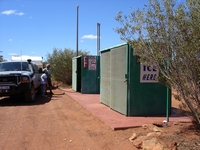
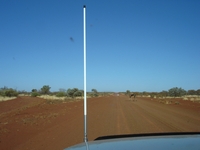
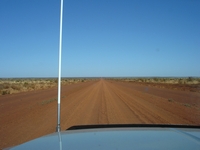
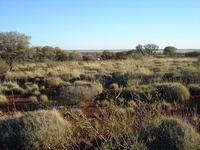
The significant damage that camels have done and are doing to fragile ecosystems, cultural sites, isolated communities,
and pastoral properties has gone largely unnoticed by the bulk of Australia’s population because of the sparse population in these
remote areas.
When road and rail transport became widespread, many of the camels were released, and being a desert animal, they thrived in the Australian
outback. There are now more wild camels in
Camels were brought into
This roadhouse claims to be the most isolated roadhouse in
We saw small birds flying out of a tiny water hole at the edge of the road. Despite the desert area and extremely low rainfall,
water can be found and wildlife such as these birds and the many camels we saw know where water can be found.
Vegetation varied between treeless spinifex plains, low scrub and mulga woodlands as we headed furthe west.
There were
occasional sand ridges and just a few rocky outcrops. The headwind became stronger and it was very dusty, forcing us to stop
early behind one of these breakaway outcrops.
There were numerous small wildflowers and flowing shrubs scattered amidst the spinifex.
Empress Springs is 64 kilometres north of the Great Central Road along the David Carnegie Road (four wheel drive recommended),
turning north 15 kilometres west of the Tjukayirla Roadhouse. The spring is inside a cave accessed by a chain ladder into a seven
metre deep rock hole.
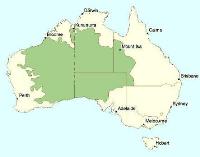
There were many missed opportunities for sightseeing excursions along the Western Australian section of the
We continue west on the Great Central Road.

Giles Breakaway fifty kilometres north east of Laverton, on the south east side of the road. We did not stop to walk around this landmark, nor take the track where a divide in the breakaway known as Desert's Gate was named by explorer Frank Hann in 1905.
For those going into Warburton for fuel or accommodation, the stunning paintings at the Tjulyuru Regional Arts Gallery may be of interest.
The roadhouse is owned by and run on behalf of the Blackstone Aboriginal Community which is located 450 kilometres away.
The Outback Way, billed as “Australia’s Longest Short Cut”, is a 2,700 kilometre route from Laverton in Western Australia to Winton
in northern Queensland.
This travelogue has taken us from Yulara (Uluru) to Laverton via the Great Central Road. Preceding travelogues explore the areas in and around Alice Springs.
This route shares the Stuart Highway for around seventy
kilometres north of Alice Springs, which we travelled in 2009 before we continued north towards Darwin. The Plenty Highway commences
and continues to the Queensland Border.
The route continues through Queensland on the now fully sealed Donohue Highway
to Boulia, terminating at the Diamantina Developmental Road (Boulia - Mount Isa Road) around ten kilometres north of Boulia. From there the Kennedy Developmental Road (Winton Road) continues to Winton. See our travelogues commencing here for Boulia
to Winton.
See Chris and Valdis’s 2018 trip on the Plenty Highway
Original artworks and limited edition prints can be purchased on line from the Outback Way Gallery Shop.